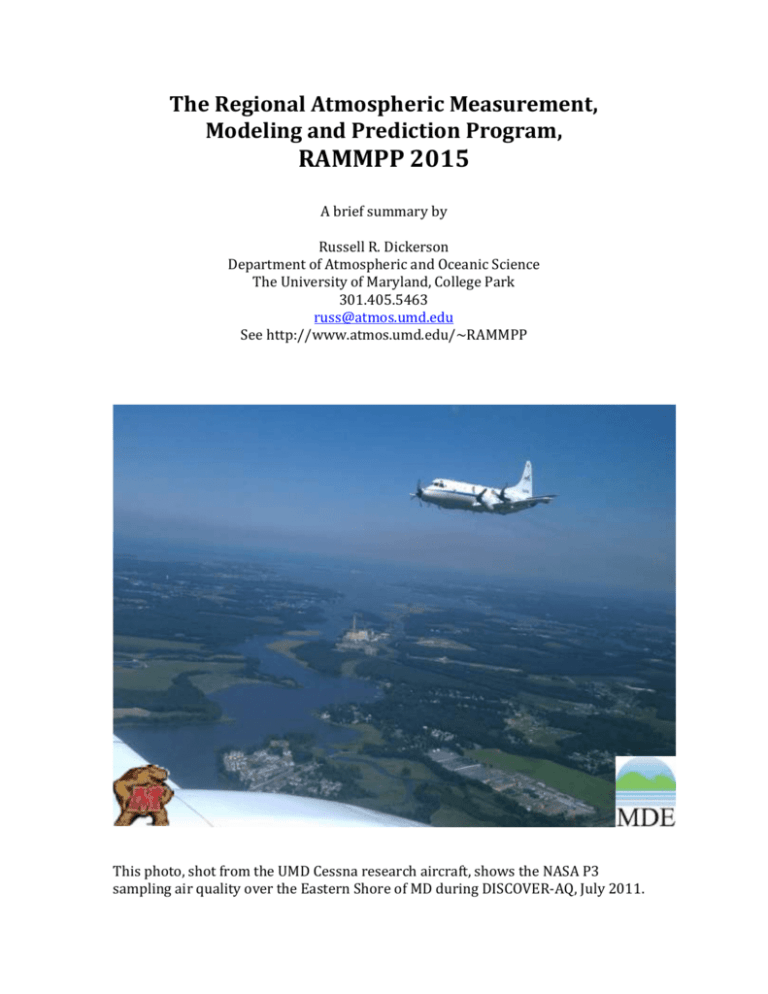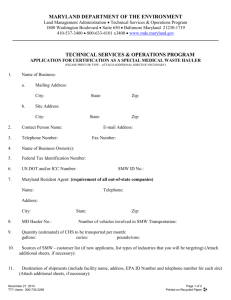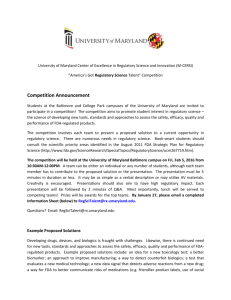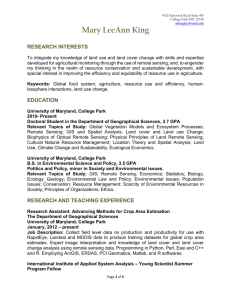The Regional Atmospheric Measurement, Modeling and Prediction
advertisement

The Regional Atmospheric Measurement, Modeling and Prediction Program, RAMMPP 2015 A brief summary by Russell R. Dickerson Department of Atmospheric and Oceanic Science The University of Maryland, College Park 301.405.5463 russ@atmos.umd.edu See http://www.atmos.umd.edu/~RAMMPP This photo, shot from the UMD Cessna research aircraft, shows the NASA P3 sampling air quality over the Eastern Shore of MD during DISCOVER-AQ, July 2011. At the University of Maryland (UMD) and the Maryland Department of the Environment (MDE) we have developed a partnership using state-of-the-art scientific research tools aimed at a more informed understanding of the influences controlling air quality over the mid-Atlantic region of the United States. The Regional Atmospheric Measurement, Modeling and Prediction Program (RAMMPP) involves a number of integrated research elements: o Air Quality Forecasting o Measurements Surface Aircraft Satellite o Meteorological Modeling o Chemical Transport Modeling These components represent a balanced approach involving experiments and numerical simulations, as indicated in the following diagram. MDE provides guidance to assure that research focuses on policy relevant science. (Regional Atmospheric Measurement Modeling & Prediction Program) Balanced Theory & Observations WRF Dynamical Model 12-0.5 km Resolution Forecasting Chem/Trans Models CMAQ Modular Open Code Collaborative w/EPA and WRF-CHEM Input Emissions Inventories SMOKE (Chem Engineering) Interactive Photochem. Aerosols Transport Deposition Observations Surface: Beltsville Greenbelt Piney Run Aloft Cessna Aircraft NASA P3 Profiler Sondes Remote (NASA & NOAA) AERONET GASP (AOD) MOPITT (CO) MODIS (particles) OMI (NO2, SO2) PANDORA (NO2, SO2) SCIAMACHY (SO2, NO2, H2CO…) Expertise developed at the University of Maryland while working on global atmospheric chemistry and climate issues is being applied to Maryland’s air (and more recently water) quality issues. With a 15-year record of cooperation, UMD and MDE have been applying world-class research in meteorology, chemistry and physics to reduce ground-level ozone, particulate matter and haze in Maryland. The partnership has resulted in science based policy decisions at the State and National level, dozens of reviewed scientific publications, and eight Ph.D. students trained. Professors Hudson and Dickerson won the 2009 UMD Regents’ Award for RAMMPP’s service to the State. Major accomplishments Demonstrated, through measurements and models, the role of westerly transport (from upwind states) in Maryland’s air quality, which led to successful control measures. Showed that reductions in NOx emissions are more effective in controlling O3 than are reductions of VOC’s and that ozone events have a spatial scale greatly exceeding the borders of Maryland. Performed numerical simulations to test abatement strategies for State Implementation Plans (SIPS) and other projects. Discovered that reductions in SO2 emissions will be neutral or beneficial in controlling Maryland’s ozone. Showed that transport from the south, through for example the Low Level Jet, can impact Maryland’s air quality. Performed computer simulations of the weather in Baltimore to show that the heat island effect is driven in part by upwind urbanization and that improving tree cover in the suburbs can reduce temperatures and improve air quality in the City. Used in situ and remote measurements of NOx to show that ozone is regional in nature. Measured aircraft profiles of air pollution to show that the air entering Maryland already contains ozone at concentrations near or above the standards. Analyzed surface measurements to show that PM2.5 and haze are regional in nature. Performed aircraft and Lidar observations to improve the representation of vertical mixing in numerical simulations. Collaborated with NASA to bring to bear their extensive measurement and modeling capabilities on Baltimore and Washington, D.C. air quality in DISCOVER-AQ. Developed a collaboration with NOAA to improve remote sensing and air quality forecasting for MD. Developed a collaboration with EPA to share modeling results and aircraft measurements. Evaluated and improved emissions inventories. Showed that Edgewood’s unusual geography and meteorology (e.g., the Bay breeze) leads to unusually high air pollution. Used in situ and remote measurements of SO2 to show that power plant emissions are quickly transformed to aerosols but that these aerosols have a relatively long lifetime and are exported from one state to another. Used a high-resolution weather model to show that urban areas make zones of stagnation in downwind areas such as Beltsville and Edgewood. Discovered dramatic improvements in air quality during the 2003 Electrical Blackout demonstrating that reductions in power plant emissions can have a rapid impact on ozone and PM well down wind. Key University Personnel RAMMPP Principal Investigator Meteorological Modeling Emissions Modeling Photochemical Modeling Measurements State Climatologist Prof. Russell Dickerson Prof. Da-Lin Zhang Prof. Sheryl Ehrman Dr. Timothy Canty Dr. Hao He Prof. Ross Salawitch Dr. Xinrong Ren Dr. Konstantin Vinnikov October 2011 RAMMPP meeting at MD Dept. Environ. on DISCOVER-AQ The RAMMPP team and interested parties from MARAMA, UMBC, NOAA, and NASA.











